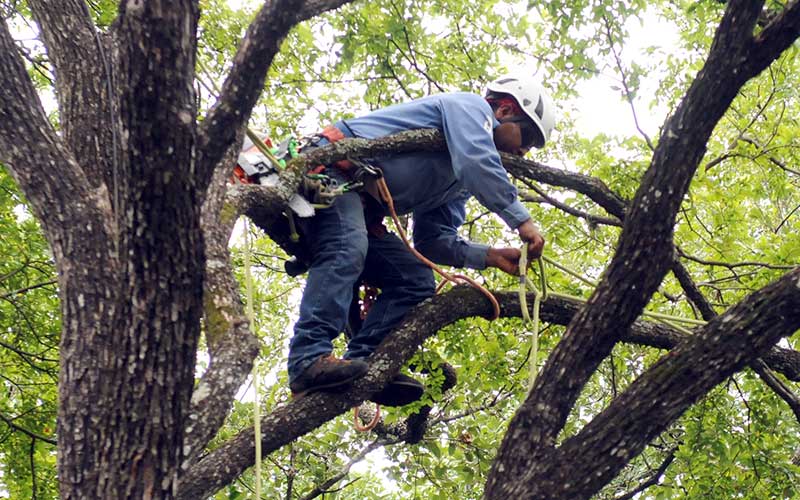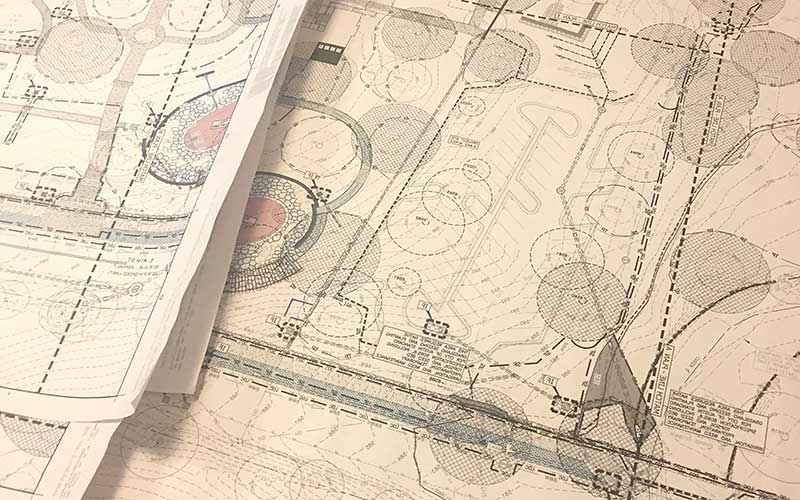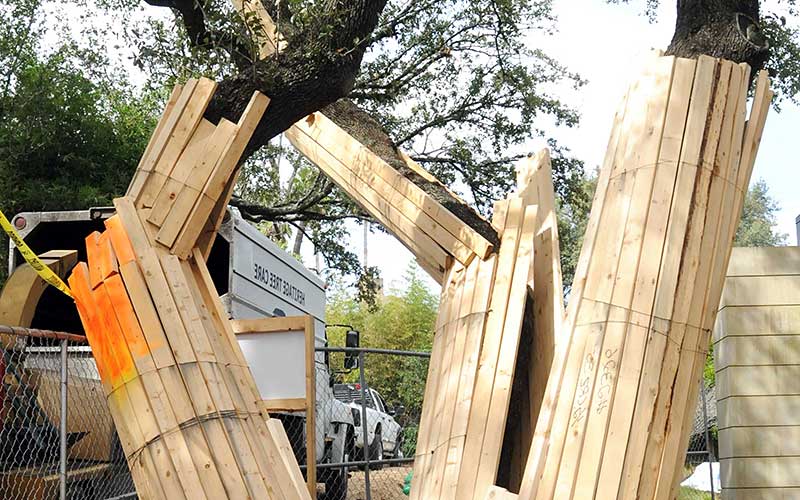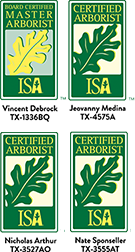Structural Tree Pruning Promotes Sound Tree Health
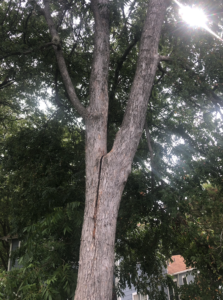
An uncorrected defect that was not fixed when the tree was younger resulted in weak branch attachment and a deep split that resulted in the complete loss of a large tree.
Structural pruning strengthens the framework that will help trees resist failure over their entire lifespan. Yes, choosing the right tree for the location, proper planting technique, watering, and organic soil care are critical for healthy trees. But surprisingly, few people understand the basics of shaping the tree, especially when it’s young.
Container-grown trees often come from the nursery with problems that worsen over time. Tightly packed growing areas promote codominant stems, and tight V-forks cause included or pinched bark. These problems can lead to splitting as the tree grows.
An ethical tree service wants to see trees flourish. Arborists don’t want to see majestic oaks split apart in a windstorm or a fifty-year-old cedar elm losing large limbs because property owners neglected proper pruning when the trees were young.
From the time you plant a tree, it’s essential to keep its future shape in mind. It can take up to twenty-five years of gentle training to overcome structural defects. Healthy, properly shaped trees need much less pruning.
Benefits of Careful Pruning
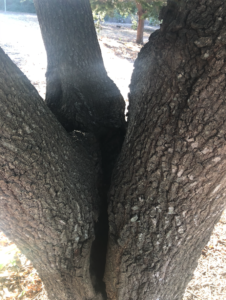
This tree has multiple dominant stems, resulting in splitting as the tree matures due to weak branch attachment.
The many benefits of early, carefully planned pruning include:
- It helps create one dominant trunk to form a strong base.
- Spaces the branches evenly for a balanced canopy.
- Avoids weak Y-shaped structure that splits easily.
- Reduces the likelihood of wind damage.
- Improves clearance over sidewalks and structures.
- Avoids the eventual need to remove large branches.
Get Started With Structural Pruning of Young Trees
There are a few essential concepts to understand before grabbing your saw and pruners. Here are the primary purposes of early pruning:
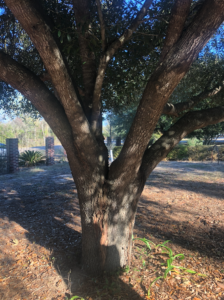
A young tree that has been pruned without structural pruning in mind has developed multiple dominant stems and will likely have issues as the multiple stems continue to grow.
Create one strong main trunk.
Landscape trees are generally trained to have one dominant trunk, also known as a leader. You want to avoid having many trunks of similar diameter because this makes the tree vulnerable to splitting.
Step back and observe your tree from all angles. Choose the strongest and tallest trunk to be the dominant one. Any additional trunks will be removed, or cut back, or reduced. This allows the main trunk to outgrow the ones you’ve cut back while the leaves on the shortened branches support the tree’s growth.
During the first five to ten years of a tree’s life, continue to make sure the tree has a dominant leader. Reduce or remove competing branches when necessary.
Avoid weak scaffold joints.
Remove or reduce branches that are over one-half the dimension of the trunk. Even if these competing branches are only pencil-sized, removing or shortening them now will help create a sturdy tree.
Remove selected branches.
Branches that are parallel, crossing, clustered, damaged, or directed back toward the trunk will cause structural problems as they grow. Remove these branches during each pruning cycle.
You never want to remove over 25% of the foliage in any one pruning cycle.
Decide on the height of the permanent canopy.
You can gradually raise the canopy as the tree reaches about five-years-old. Often you need clearance under a tree for pedestrians or to raise the tree above a structure.
Once you decide on the lower limbs’ height, remove any branches lower than this mark.
Establish the scaffold branches.
Over the years, you need to identify the branches that will form the tree’s primary structure. They should be evenly spaced around the tree to avoid it being lopsided. Reduce branches that are within 18 to 36 inches of another scaffold branch to avoid clustered branches.
-
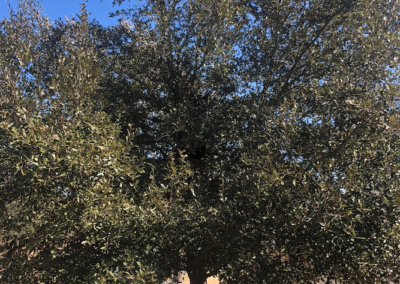
Before: Healthy young tree growing too much leaf canopy with multiple stems and no defined structure for stability as the tree matures.
-
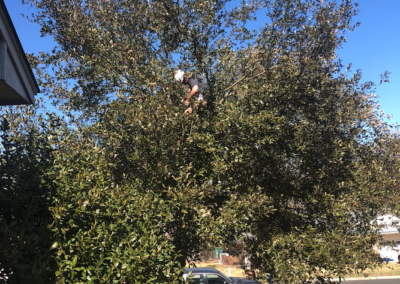
During: A certified arborist climbs the tree and trims the correct branches and stems to achieve the desired result.
-
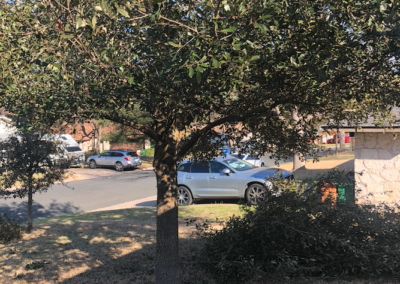
After: The tree has been pruned to promote long-term positive structural growth. The arborist was careful to remove less than 25% of the canopy.
-
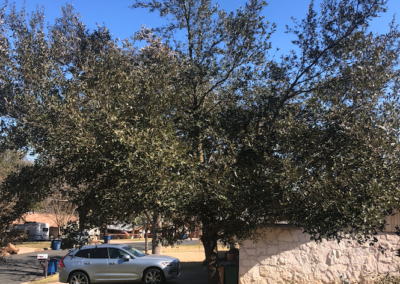
After: The tree has been pruned to allow the dominant stem to prevail while maintaining a healthy canopy that will adjust rapidly.
Resources to Help You Understand Pruning
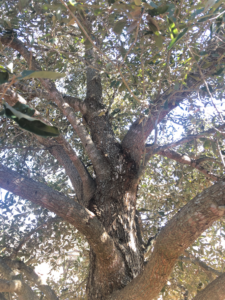
Lack of structural pruning affects a tree higher in the canopy, where multiple large stems grow too close together for optimal tree health and stability.
Before you cut anything, visit this University of Florida website, which has many clear diagrams to visualize your goals.
Central Texas Live Oaks pose additional challenges and often require the help of a local tree service. Read this article from The International Oak Society to read more about their specific pruning requirements.
For general information on proper pruning techniques, visit the Texas A & M site.
Tree work can be dangerous and can damage trees if not done correctly. If in doubt, call a qualified tree service before you get started.
Your trees can provide trouble-free beauty and shade for many years to come if pruned to promote good structure. Heritage Tree Care is happy to consult with you and develop a long-term tree care plan, including preventive pruning.
